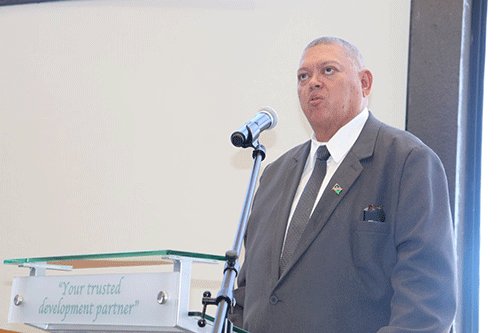Fisheries and Marine Resources minister Derek Klazen said since inland and commercial fishing as well as aquaculture all resort under one ministry, these sectors should coordinate and leverage their activities to ensure they benefit the entire nation.
This was his plea when visiting the Hardap Inland Aquaculture Centre (HIAC) last week at the Hardap Dam Resort outside Mariental.
“We are one family in the Namibian house, and I am hereby urging those involved in the commercial fishing sector to respond more aggressively to their corporate social responsibility towards the nation by, for example, drilling boreholes where there are water scarcities and constructing classrooms where learners need to be accommodated,” he explained.
In terms of challenges experienced at the centre, he advised staff to approach Treasury for exemption when critical goods and services are required to ensure the sustainability of the centre.
“My office is not so far from you; please come and see me so we can work together to iron out your challenges when they arise,” he said.
Speaking at the same event, Hardap governor Salomon April said Hardap residents should make optimal use of fish at the river near Hardap dam as a means to sustain themselves and help address the dire socio-economic circumstances the region is experiencing.
“The staff members representing the fisheries ministry in the region should feel free to visit my office so that we can see how best to let Hardap region’s residents benefit from fish bred at the inland aquaculture centre outside town,” he said.
Kaulo Salushando, a fisheries research technician at the centre, explained to the delegation that they normally placed fish at a ratio of five males – three females in ponds at the centre for one month of breeding.
“Afterwards, we normally harvest fingerlings with an average size of five centimetres, which will afterwards be sold to then sold and/or distributed to the general public who wish to continue growing them to a marketable size for own consumption or sell for income, and to also provide other regions who are involved with inland aquaculture,” she said.
Chief fisheries biologist Gosbert Hamutenya said the core functions performed at the centre are inland fisheries biological surveys, fingerling production, aquaculture extension services, aquaculture and inland fisheries research, fish production as well as aquaculture training and awareness.
“The objectives of the inland fisheries department are to conduct annual biological surveys, aimed at assessing and monitoring the status of fish stocks in the Lower Orange River, Hardap Dam, Naute Dam, Swakoppoort Dam and Von Bach Dam,” he added.
According to Hamutenya, about 148 000 fingerlings of Mozambique tilapia (Oreochromis mossambicus) were produced since the beginning of last year.
“About 41 000 of the fingerlings were sold and distributed to the general public for their fish farming projects, while about 58 000 were stocked at our centres,” he said.
– sklukowski@nepc.com.na


